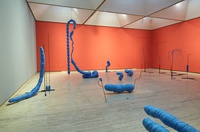Mira Gojak
2019
Displayed 2019 at Art Gallery of New South Wales

Mira Gojak
Born 1963, Adelaide. Lives and works Melbourne
Mira Gojak’s drawings and sculptures attempt to trace how the contours of the forces of gravity, weight, suspension and resistance can be experienced in the body. Her sculptures are enacted as drawings in space that materialise a place where the distinction between the internal and external is unclear. Here the idea of the void becomes a site, as a result of actions played out, in and through time. Gojak has been concerned in her recent works with the blue sky and its apprehension in light of recent conceptions of change and possibility in the time of the Anthropocene.
Photograph: Christian Capurro
Artist text
by Helen Hughes
A banal observation, perhaps, but where we must begin: Mira Gojak marries the mediums of drawing and sculpture. Her lines on paper balloon and mushroom, stutter and repeat across the page. The accumulation of lines that constitute her sculptures, made from hand-formed wire, copper tubes, steel rods and yarn, too, are echoic but expand majestically through space, like sound, or ink dropped in water. Distinctively, whereas Gojak’s works on paper are typically executed in black and white, her sculptures are often made in colour, thereby collapsing the Renaissance binary of disegno e coloriti, where colour is understood as an entity that blurs and bleeds and line as that which contains and gives order. In her sculptural works, Gojak draws through space with colour.
In recent years, Gojak has been drawing through space with a very specific colour: sky blue. For the 2016 exhibition Distant Measures, she used sky-blue yarn to measure the vertical distance from the ground underfoot to the top of the earth’s stratospheric layer, chasing that point where, if one were looking down on earth from space, the sky’s blue begins to ‘run out’ and turn into the blackness of outer space, somewhere between 50,000 to 60,000 metres up. (1) For Gojak, this point can be conceived as the limit of what Rebecca Solnit refers to poetically as the ‘blue of distance’: the ‘blue at the far edge of what can be seen’. (2)
The origin of these blue yarn works is traced to a residency that Gojak undertook in Barcelona in 2014. Here, she looked out her studio window onto the open sky and noticed a myriad of white contrails – the vapour-trail drawings made by airplanes – striating the otherwise uninterrupted field of blue. Typically, the sky is figured as a limitless entity, becoming a metaphor for total freedom, imagination or infinity. But framed by a window and crisscrossed with white streaks of frozen condensation, it was momentarily captured, contained. Every morning during the several months of her residency, Gojak photographed these contrail drawings, which would become the seeds for the sky-blue yarn sculptures.
Where earlier sculptures expand through space, the blue yarn sculptures harbour an oppositional movement: they are implosive, centripetal as opposed to centrifugal. Here, the lengths of yarn are wound tightly, repetitively, obsessively around black steel armatures that snake and fork sideways and upwards from the ground to form dense, concentrated masses of line; bundles of blue. If Fred Sandback’s minimalist yarn installations from the 1970s onwards utilised a precise and economic geometry to open the artwork onto its environment, then Gojak’s wound yarn sculptures collapse space (or distance), exerting a gravitational or magnetic pull. As opposed to a sonic echo, the blue here is a muting force, like Beuys’ felt-covered piano. The blue hugs the black, rendering the sky as though it suffered from vertigo. This shouldn’t surprise us, for the lengths the yarn must travel to reach the top of the earth’s stratosphere are huge, distances so great that the artist could no longer keep tally of them, instead finding it easier to weigh the lengths of yarn used per sculpture once completed. If the space separating one from the blue horizon feels like a void, here Gojak renders it as a tactile mass. The weight of distance. (3)
Notes
(1) In 2017, Gojak reworked these sculptures for an installation as part of the contemporary sculpture exhibition Future Eaters, curated by Charlotte Day, at Monash University Museum of Art, Melbourne.
(2) She continues: ‘that colour of horizons, of remote mountain ranges, of anything far away’; Rebecca Solnit, A Field Guide to Getting Lost, Canongate, Edinburgh, 2006, p.29.
(3) When Gojak finally weighed the mass of blue yarn used in Distant Measures, she realised there was approximately enough to travel to the top of the earth’s stratospheric layer and back again: 102,791 metres.


